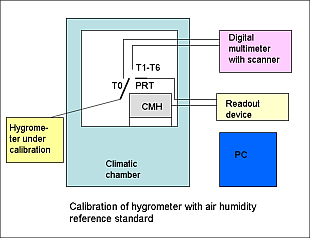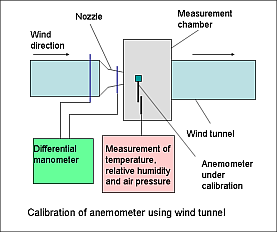- About Testing Centre
- Services
- Training
- Research and Development
- Feedback
- Contacts

Reference standards
We preserve and develop air velocity and air humidity reference standards since 2004 when Estonia acquired these on the support of Phare Project “Development of conformity Assessment Infrastructure in the Field of Metrology. Since July 2010 these standards have been designated as reference standards by governmental decree. The measurement ranges and measurement capabilities of the reference standards can be found here. You are welcome to contact Martin Vilbaste (contact data on our contact page) for getting more information.
Air humidity reference standard
The working principle of the secondary standard of air humidity is explained below.

Calibration is carried out in a climatic chamber (Weiss Umwelttechnik GmbH) that controls the temperature and relative humidity inside the chamber. The chilled mirror dew-point hygrometer (CMH) inside the climatic chamber is the actual reference instrument. Air temperature inside the climatic chamber is measured by a platinum resistance thermometer (PRT). The temperature homogeneity in the measurement volume is measured by a multimeter (Time Electronics) that measures thermal voltages generated by differential thermocouples T1 to T6 with respect to the reference thermocouple T0. During calibration the device under calibration is placed close to the sampling tube of the chilled mirror hygrometer and the PRT. The reference value of relative humidity is calculated by measured dew-point temperature and air temperature values. Thus the reliable measurement of these two temperatures is very important. The chilled mirror hygrometer is periodically calibrated in Finland at VTT (previously at MIKES). and the air temperature measurements are traceable to Estonian National Standard of Temperature (AS Metrosert). We have constructed a simplified dew-point generator in order to check the readings of the chilled mirror dew-point hygrometer. The output of the humidity generator is flowing air with certain dew-point temperature.
We have participated in the following relative humidity and air temperature related interlaboratory comparisons:
- Bilateral relative humidity intercomparison measurement between MIKES and Testing Centre in 2004 (EURAMET Project No 808)
- HUMI-02 (Calibration of a portable digital humidity and temperature instrument). The pilot laboratory was Danish Technological Institute. Testing Centre carried out the measurements in 2007 and the final report was made available in 2008.
- HUMI-03 (Calibration of a portable digital humidity and temperature instrument). The pilot laboratory was Danish Technological institute. Testing Centre carried out the measurements in 2011 and the final report was made available in 2012.
- Bilateral relative humidity intercomparison measurement between VTT MIKES and Testing Centre in 2016 (Project No. M-16H080)
- EURAMET air temperature intercomparison measurement “Comparison of air temperature calibrations” (EURAMET Project No P1061). Testing Centre carried out the measurements in 2010 and the final report was made available by MIKES that served as the pilot laboratory.
- Bilateral air temperature intercompartison measurement between AS Metrosert and Testing Centre in 2017
Air velocity reference standard
The reference standard of air velocity is made up of Wind Tunnel Standard and Rotary Jib Standard. The Wind tunnel Standard has been acquired on the support of the Phare 2001 project and the Rotary Jib Standard has been constructed as a development work. The following scheme explains the calibration of anemometers using the Wind Tunnel Standard.

The wind tunnel is used to generate air flows of different values. The nozzle of the wind tunnel changes the air flow profile in the measurement chamber flat. The anemometer under calibration is placed in the measurement chamber. The pressure difference over the nozzle as well as air temperature, pressure and relative humidity in the measurement chamber are measured in order to calculate the reference value of air velocity. The measurements are traceable by calibrated Pitot tube and differential manometers. The Pitot tube is used for finding the wind tunnel nozzle factor.
Since the Wind Tunnel Standard does not enable to calibrate
- anemometers at lower velocities than 0.5 m/s
- larger rotating vane anemometers
we have constructed the Rotary Jib Standard.
We have participated in the following air velocity intercomparison measurements:
- Bilateral intercomparison measurement between Lthuanina Energy Institute and Testing Centre in 2005
- EURAMET M-FF_K3 key comparison. The pilot laboratory was NMi VSL from Netherlands. Testing Centre carried out the measurements in 2007 and the final report was made available in 2008.
- Bilateral intercomparison measurement between Jormita OY (Finland) and Testing Centre, University of Tartu in 2013.


